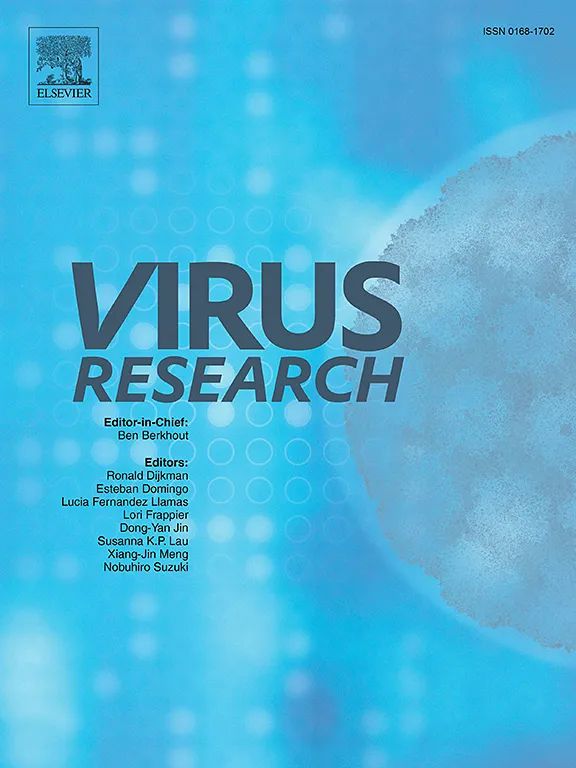Martellivirales目中一种多节段杆状分枝病毒的特征,主要适应植物病毒。
IF 2.7
4区 医学
Q3 VIROLOGY
引用次数: 0
摘要
Riboviria领域的Martellivirales目包括七个已建立的家族。这一目的病毒具有单链正义RNA基因组,可感染动物、植物或真菌。在这项研究中,我们鉴定了黄曲霉活病毒1 (AfViV1),这是一种感染黄曲霉的RNA病毒,可能属于Martellivirales目的“活病毒科”。在以往的报道中,与“活病毒科”相关的多个RNA依赖性RNA聚合酶(RdRP)序列主要是从元转录组数据中鉴定出来的。然而,它们的病毒学特征尚未披露。分析结果表明,AfViV1病毒粒子具有不同长度的棒状结构,并鉴定出由AfViV1的RNA12编码的外壳蛋白(CP)。利用AfViV1-CP序列,根据序列读取档案(sequence read archive, SRA)数据,我们检测到了来自“活病毒科”病毒的几个潜在CP序列。这些数据表明,这个科的病毒具有类似的杆状结构。有趣的是,AfViV1-CP氨基酸序列与已知的病毒CP没有显著相似。然而,预测的结构与Potyviridae (Patatavirales)和Closteroviridae (Martellivirales)科(和目)的杆状病毒相似。我们的分析描述了第一个具有棒状颗粒的多节段真菌ssRNA病毒,扩展了真菌RNA病毒的形态多样性。此外,本研究强调了真菌病毒和植物病毒之间的相似性,表明它们在宿主范围、宿主适应等方面存在着深刻的关系。本文章由计算机程序翻译,如有差异,请以英文原文为准。
Characterization of a multi-segmented rod-shaped mycovirus within the order Martellivirales largely accommodating plant viruses
The order Martellivirales in the Riboviria realm includes seven established families. The viruses in this order have a single-stranded positive-sense RNA genome and infect animals, plants, or fungi. In this study, we characterized Aspergillus flavus vivivirus 1 (AfViV1), an RNA virus infecting Aspergillus flavus that presumably belongs to the proposed “Viviviridae” family in the Martellivirales order. In previous reports, multiple RNA-dependent RNA polymerase (RdRP) sequences related to “Viviviridae” were mainly identified from metatranscriptome data. However, their virological characteristics were not disclosed. Our analysis showed that the AfViV1 virion exhibited a rod-shaped structure with varying lengths and identified the coat protein (CP) encoded by RNA12 of AfViV1. Using the AfViV1-CP sequence, we detected several potential CP sequences from viruses in the suggested “Viviviridae“ family based on sequence read archive (SRA) data. These data suggest that viruses in this family have similar rod-shaped structures. Interestingly, the AfViV1-CP amino acid sequence was not significantly similar to the known viral CP. However, the predicted structure was similar to rod-shaped viruses in the Potyviridae (Patatavirales) and Closteroviridae (Martellivirales) families (and orders). Our analysis describes the first multi-segmented fungal ssRNA virus with rod-shaped particles and expands the morphological diversity of fungal RNA viruses. Additionally, this study highlights the similarities between fungal and plant viruses, suggesting their deep relationships concerning host range, host adaptation, and more.
求助全文
通过发布文献求助,成功后即可免费获取论文全文。
去求助
来源期刊

Virus research
医学-病毒学
CiteScore
9.50
自引率
2.00%
发文量
239
审稿时长
43 days
期刊介绍:
Virus Research provides a means of fast publication for original papers on fundamental research in virology. Contributions on new developments concerning virus structure, replication, pathogenesis and evolution are encouraged. These include reports describing virus morphology, the function and antigenic analysis of virus structural components, virus genome structure and expression, analysis on virus replication processes, virus evolution in connection with antiviral interventions, effects of viruses on their host cells, particularly on the immune system, and the pathogenesis of virus infections, including oncogene activation and transduction.
 求助内容:
求助内容: 应助结果提醒方式:
应助结果提醒方式:


